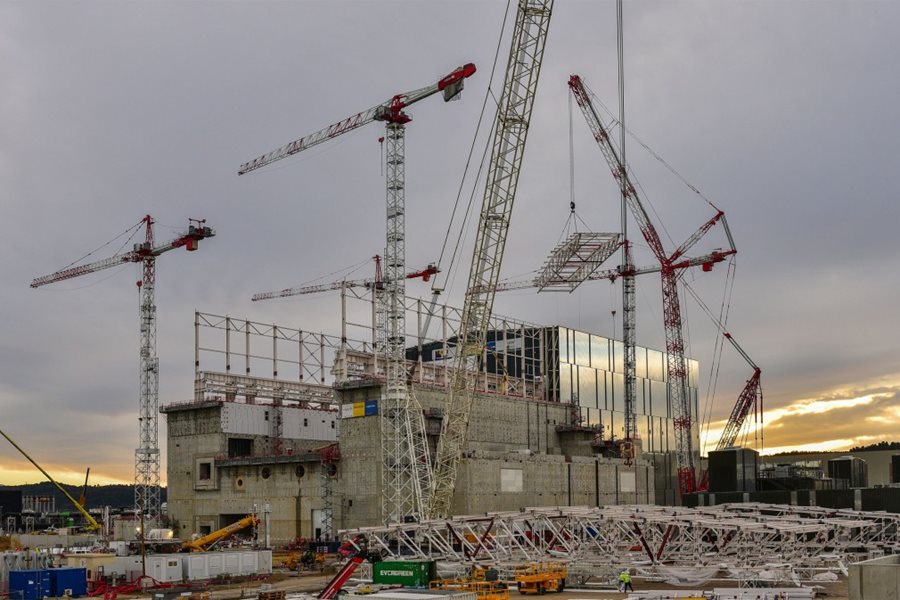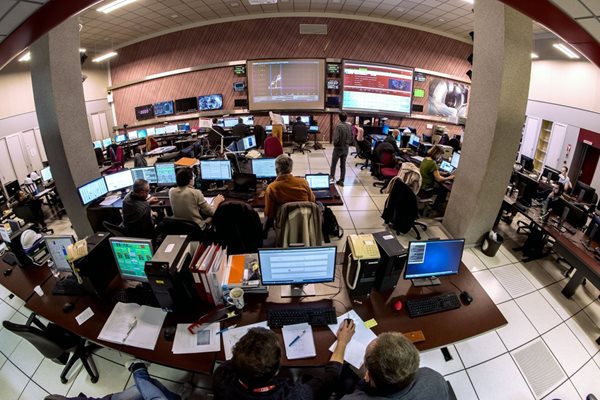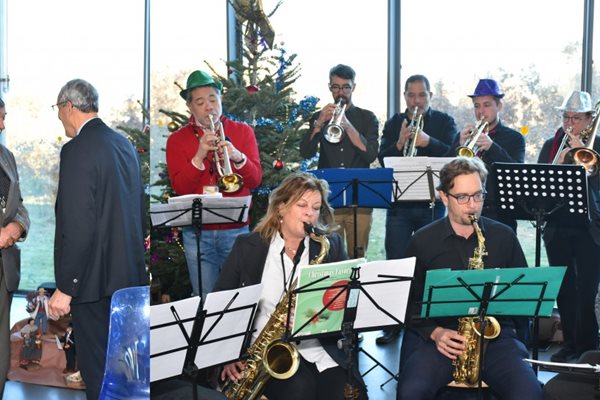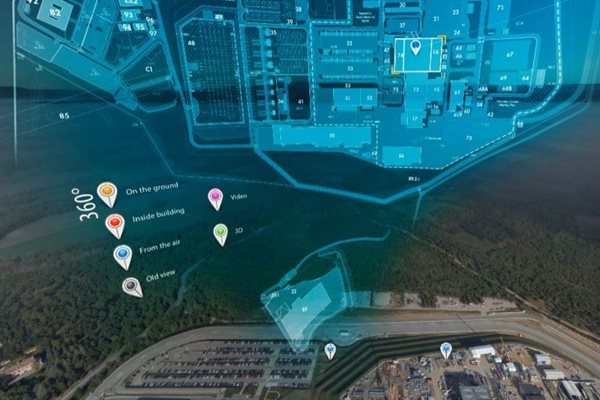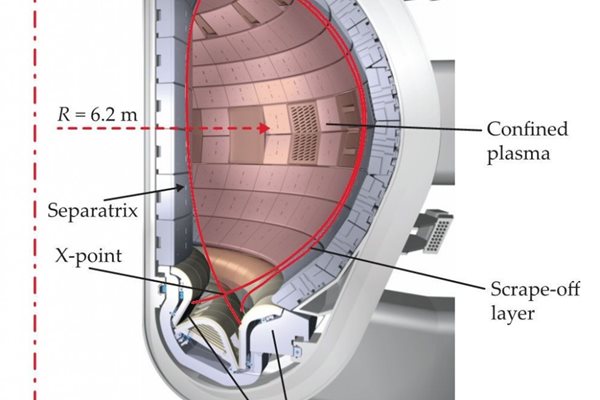
you're currently reading the news digest published from 02 Dec 2019 to 09 Dec 2019
featured4
of-interest3
press6
featured
Roof modules | Patience, precision and a crane's long arm
In the spring of 2020 a new and strategic phase of ITER construction will begin: the assembly of the ITER Tokamak. In order to deliver machine components to the assembly pit, a new volume—the crane hall—will be created at the top of the Tokamak Building and the rails of the overhead bridge cranes extended. In September, the first pillar segment of the crane hall's steel structure was installed and deeply anchored into the 'corbel' at the top of the Tokamak building. Less than three months later, with 20 tall pillars solidly in place, the time had come to install the roof structure—five 'modules' weighing between 62 and 78 tonnes and spanning the 50-metre distance between the two parallel rows of supporting pillars. The operation had been more than a year in preparation. Lifting such large structures is not just about lifting; care must also be taken in the planning of activity sequences and in coordinating works in the operation's vicinity. Unpredictable parameters—such as the force of the wind or the impact of the national strike in France on the day following the first lift—had to be taken into consideration. The roof modules had been pre-assembled on the ground about 30 metres from the Tokamak Building. Delivering them from there to their final position on top of the waiting pillars was a challenge that only a very specific type of crane could meet. Months ago, a crawler crane with a boom extending more than 100 metres was assembled on site and positioned alongside the Tokamak Complex. It was first used to lift and position the relatively 'light' elements of the columns and rail supports. In the wee hours of 4 December, as the air was perfectly still and temperature just above zero degrees Celsius, the crawler crane extended its long arm, picked up the first module and lifted it slowly above the massive walls of the Tokamak Complex to the supporting columns. For a long moment, the triangular shaped steel structure hovered in mid-air as operators pulled on ropes to pre-align it with the anchoring system on top of the columns, where other operators standing on elevated platforms were waiting to perform the final adjustments. The operation was a patient and highly precise one—two and a half hours for lifting the first module and berthing it, within tolerances of less than one centimetre, on its supports 70 metres above ground. A second module followed suit in the afternoon and a third one on Friday. Two more remain to be lifted. Once the five modules are in place and connected to one another, the rails for the bridge cranes will be extended from the Assembly Hall and installed on the thick runway beams running the whole length of the crane hall. For a few months, the Tokamak Complex will look like a big mass of concrete topped by a thin, almost fragile-looking steel skeleton. Then, as winter turns into spring, the crane hall will progressively don its final cladding of mirror-like stainless steel and grey-lacquered metal—the architectural signature of the ITER installation. The lifting and berthing operation was performed under the responsibility of the European Domestic Agency Fusion for Energy. It was coordinated by architect-engineer Engage and implemented by contractors VFR (overall responsibility and coordination), Martifer (manufacturing and installation of the steel structure) and Vernazza (lifting operations). Click here to view a time-lapse video of the lifting operation on 4 December.
WEST | Revamped tokamak completes 1st phase of operation
One day, in the latter half of this decade, it will be routine at ITER: dozens of operators, with eyes riveted to their individual monitors as numbers, graphs and real-time views of ongoing plasmas appear on large screens on the wall. Just like in the control room at WEST on an ordinary afternoon, some plasma shots will trigger applause and cheers, others will be greeted with a bit of disappointment. The session's pilot, or scientific coordinator, will ask the operator in charge of ion cyclotron heating to release a bit more power; a colleague tasked to monitor antenna temperature will warn that some hot spots are developing; there will be discussions, negotiations, suggestions ... Like a cheese soufflé, a good 'shot' relies on a delicate combination of ingredients and, at times, a chef's inspiration. At WEST, less than a kilometre away from the ITER construction site, the counter displays 55,799—the number of plasma shots since 1988 when, as Tore Supra, the midsize tokamak entered operation at CEA-Cadarache. Over the past three decades, Tore Supra has evolved into a different, almost brand-new machine: magnetic coils have been added to confine the originally circular plasma into an ITER-like "D" shape, and the carbon limiter is being progressively replaced by a tungsten divertor closely resembling ITER's. WEST is intended to be a test bed, and a risk limiter, for its big neighbour ITER. The revamped machine produced its First Plasma three years ago and has now completed Phase I of its experimental program. 'This initial phase, launched in 2017, had two main objectives, both with ITER operation in mind,' explains Jérôme Bucalossi, who heads the WEST project at CEA's Institut de Recherche sur la Fusion Magnétique (IRFM). 'One was to explore different scenarios for the transition to H-mode in deuterium plasmas; the other was to observe the interaction with the divertor's tungsten elements, particularly when operating in helium.' A test bed, however, is not a clone. 'Of course as in all present-day devices, there are limitations,' says Bucalossi. 'The divertor's geometry in WEST isn't quite the same as in ITER and, at this stage, comprises only a few actively cooled plasma-facing units. Also, we don't have a beryllium wall—ours is tungsten, more in anticipation of DEMO—and our heating systems have a very strong interaction with the plasma edge.' Whatever the differences between the two machines, the Phase I campaigns in WEST have harvested a massive amount of data. 'Now we need to go through a modelling stage in order to extrapolate to ITER and prepare future experiments in WEST.' With Phase I completed, WEST will now shut down for approximately one year, the time necessary to install the full, actively cooled ITER-grade divertor. The same Chinese company that manufactured the tungsten 'monoblocks' for the Chinese tokamak EAST will provide those for WEST. The first prototypes are presently under testing at CEA-Cadarache and the industrial follow-up will be supported by WEST's Chinese partners, the Institute of Plasma Physics, Chinese Academy of Sciences (ASIPP) and the Southwestern Institute of Physics (SWIP). At that point WEST will have acquired the capabilities required for long pulse operation and will begin producing ITER-relevant plasmas of up to 1000 seconds.
Image of the week | "Bringing light and hope"
Most international organizations are headquartered in large cities—the UN in New York, UNESCO and the International Energy Agency in Paris, the IAEA in Vienna, or the World Health Organization in Geneva. The ITER International Fusion Energy Organization, in contrast, has its home in a small village in Provence, with a population of less than 1,000 souls. ITER today has more staff than Saint-Paul-lez-Durance has inhabitants. This unique situation has created a special relationship between ITER and Mayor Pizot, who has been heading the village council since 1995. As early as 2001, Mayor Pizot was instrumental in organizing support and local government funding for the project. He has always wanted to 'serve ITER as ITER is serving Saint-Paul.' And so every year since ITER moved into its Headquarters Building in 2012, Mayor Pizot has offered the traditional fir tree that, once lit, symbolizes Nature's rebirth. 'Let us enjoy this tradition together, and let us celebrate the generosity of our neighbours in Saint-Paul-lez-Durance,' said ITER Director-General Bernard Bigot. 'This tree will brighten our lobby in the dark season, and remind us that our work here at ITER is about bringing light and hope to the planet.' Then, also in keeping with tradition, the ITER band began to play ...
Outreach in China | A week devoted to fusion
A new biennial event in China seeks to create a comprehensive exchange platform for the scientists, engineers and industries that are driving the country's strong push in fusion research development. From 25 to 29 November, Leshan City (Sichuan Province) played host to the first biennial China Fusion Energy Conference (CFEC 2019) and Fusion Energy Activities Week*. The conference organizers—China International Nuclear Fusion Energy Program Execution Center (ITER China); the Southwestern Institute of Physics (SWIP); the Institute of Plasma Physics Chinese Academy of Sciences (ASIPP); and the China Academy of Engineering Physics (CAEP)—cited three main aims for this first-of-a-kind event: highlight the latest progress and achievements from domestic research institutes, universities and enterprises in fusion R&D, engineering technology and talent cultivation; promote key physics and technology developments in fusion energy; encourage exchange and integration between academia and industry. China's participation and implementation in the construction and operation of ITER as well as the design and technology challenges for the next-phase DEMO-type device were at the centre of all discussions. Outside of the main conference, events were organized as part of Fusion Energy Activities Week. These included lectures, events to popularize fusion energy, and academic exchanges on the ITER Research Plan. * LIU Yong, former Director-General of SWIP, was the president of CFEC 2019, while LUO Delong, Director-General of ITER China and next ITER Council Chair, presided the Fusion Energy Activities Week.
of-interest
ITER public service announcement seen all over the world
From Wednesday 4 December 2019 through 28 January 2020 a public service announcement on ITER will be a regular feature on the Euronews network, which has a global reach of 430 million households (including 170 million European households) in 166 countries. The goal is to raise awareness of the ITER Project, the promise of fusion, and Europe's leadership as the host Member—working together with China, India, Japan, Korea, Russia, and the USA—to bring to reality the most complex science experiment ever attempted. The 20-second promotional spot has been filmed in five languages (English, French, German, Spanish, and Italian). It is scheduled to air two- to three-times daily, or approximately 70 times in December and another 70 in January. You can watch the public service announcementson the ITER YouTube page in English, French, German, Spanish or Italian.
360° virtual tour updated
The 360° virtual tour of ITER construction has been updated with drone footage from October 2019. Fly in, out and over the principal buildings of the ITER worksite by clicking on the coloured teardrop-shaped markers: red to follow a drone inside the buildings, yellow for a tour at ground level, or blue if you prefer to stay at bird's eye view. Accessible from the home page of the ITER website (yellow icon) or by clicking on the link below, the 2D tour requires no special equipment to enjoy. (If you do have 3D glasses, click on the yellow goggle symbol at the bottom left of your screen.) Make sure you don't miss out on the 'Tokamak 3d/Pit' button (blue site map, blue teardrop). It's a spectacular virtual visit of the completed plasma chamber. Click here to enter the latest 360° ITER virtual tour.
The challenge and promise of burning plasmas
In the December 2019 issue of Physics Today (Volume 72, Issue 12), two physicists explore the ways in which ITER will be a major step in "bridging the gap between current understanding and the knowledge needed to design and operate fusion power plants as safe, sustainable energy sources." Richard J. Hawryluk* (Princeton Plasma Physics Laboratory's associate director for fusion) and Hartmut Zohm (director at the Max Planck Institute for Plasma Physics, Garching) enumerate the open questions that are expected to be answered or clarified during ITER experimentation—heat and particle transport in the plasma core, stability of the edge region, plasma-boundary interactions, and alpha particle heating. "Experiments [at ITER] will be a unique opportunity to study burning plasmas, develop the tools needed to better understand them, and validate outstanding predictions. The experiments will provide seminal answers to questions that are central to the prospects for fusion." Significant fusion power has only ever been achieved in two devices—and only for a little less than one second: up to 10 MW in the Tokamak Fusion Test Reactor (US), and up to 16 MW in the Joint European Torus (UK). ITER—with the capability to produce 500 MW of power for more than 300 seconds—will enable "the first in-depth study of burning plasmas in a magnetic confinement configuration." Read the full article here: "The challenge and promise of studying burning plasmas," Physics Today 72, 12, 34 (2019); doi: 10.1063/PT.3.4363. *Richard Hawryluk was also the ITER Deputy Director-General for Administration from 2011 to 2013.
